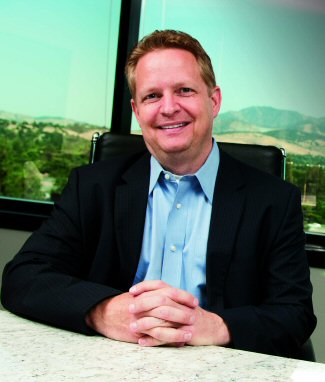
BENEFITS SERVICES ARE BIG BUSINESS
Powered by acquisitions and organic growth, EPIC gears up to serve the middle market
By Len Strazewski

|
BENEFITS SERVICES ARE BIG BUSINESS Powered by acquisitions and organic growth, EPIC gears up to serve the middle market By Len Strazewski |
| EPIC’s President Peter Garvey (middle standing) and Northern California Employee Benefits Leadership. From left: Thomas E. O’Neil, President Western Region; Matthew T. Sears, CEBS, CMS, Regional Director Employee Benefits; David Wiesner, Regional Director; John Connell, President, Western Region Employee Benefits; Beth Barr, Senior Vice President, Agency Operations. |
Creating a new national insurance brokerage is a monumental challenge, but even when the biggest building blocks are in place, the work continues, says EPIC Insurance Brokers and Consultants President and Chief Operating Officer Peter Garvey.
One of the biggest challenges for one of the newest national insurance competitors is the assembly of a national employee benefits services platform that can allow the company to respond to the increasingly complex needs of middle-market employers, he explains.
The San Francisco-based company was launched in 2007 and has grown from $5 million to $160 million in revenue this year. The company is now ranked as the 46th largest insurance brokerage in the world, according to London-based Finaccord Market Research.
The rapidly growing employee benefits practice is ranked 20th in the nation by Employee Benefit Adviser in Arlington, Virginia. Employee benefits services accounts for about 28% of gross revenue, Garvey says, and is growing rapidly as the company continues to expand through acquisitions and organic new sales.
"Part of our strategy since day one of our development has been to grow rapidly through a pattern of targeted acquisitions," he explains. Energized by new partner The Carlyle Group, a global asset manager, which acquired a controlling equity stake in the company in late 2013, EPIC has been steadily building its employee benefits resources with strategic acquisitions and new internal programs.

|
| "Part of our strategy since day one of our development has been to grow rapidly through a pattern of targeted acquisitions." -Peter Garvey CEO and President |
The company has about 185 employees specializing in employee benefits services in 12 of its 25 offices and presently services about 1,500 client employers.
Since the relationship with Carlyle began late last year, EPIC has made several agency and personnel acquisitions designed to expand employee benefits services nationally, a stage of "hyper growth" that Garvey says has allowed the company to assemble key personnel in national business centers.
The firm targets middle-market employers with 100 to 5,000 employees, a group Garvey says is "an increasingly underserved segment," requiring many of the same strategic resources as larger employers but lacking the internal management and technology to execute the strategies.
Many of the new acquisitions include benefits experts with experience at larger employee benefits consulting companies that have developed strategies and approaches that can now be directed to a small business segment, he says,
These middle-market employers require a mix of traditional employee benefits consulting and insurance brokerage services and executive administrative resources, including benefits administration technology, wellness and health management services, he says.
"Smaller employee benefits brokers may not be able to provide the depth of service these employers now require to meet the demands of their competitive strategies and Affordable Care Act compliance, which requires a new level of sophistication and administration," he says.
The benefits services also support strong crossover sales from the property/casualty insurance business segment, he notes. EPIC's solid P&C base provides a platform of relationships that can seed employee benefits growth. However, he notes that the firm's success in meeting the demands of employee benefits programs has also attracted new business to property/casualty operations.
John Connell, president of EPIC's western region employee benefits services, says the company's greatest strength may be in the higher end of the middle-market segment-employers with about 3,000 employees. The larger groups provide a critical mass that can allow for the most efficient use of self-funding and health care management programs to create organizational control over health care costs.
Employers have an opportunity under ACA to use a variety of new organizational tools, including Accountable Care Organizations, private exchanges and other services that can influence the health and health costs of their employees.

|
| "Many employers are capable of self-funding benefits costs, which can give them access to private exchange structures and more flexibility in plan design." -John Connell President, Western Region Employee Benefits |
EPIC provides a range of benefits administration platforms, wellness services and human resource management consulting that can meet the increasing needs of these employers and provide flexibility in delivering more sophisticated benefits and human resources strategies.
"The elephant in the room is automation," Connell says. As employer needs grow in sophistication and need for compliance, employers look toward more outsourcing of benefits administration.
EPIC's ability to provide administrative services is critical to the firm's future in employee benefits, he says.
Despite the emphasis on middle- market employers and their expanding needs, EPIC is not neglecting smaller employers with 100 or fewer employees, Connell says. Though the ACA has limited health plan options for some very small employers, organizations with 100 employees or more have opportunities to participate in strategies previously reserved for large organizations.
"There are still opportunities to get these plans right for their companies," he says. "Many employers in this size range are capable of self-funding benefits costs, which can give them access to private exchange structures and more flexibility in plan design."
One of the biggest challenges has been assembling the components of a contemporary employee benefits practice that can be shared and implemented nationally, executives say. EPIC is not only expanding its expertise through acquisition, but is also investing heavily in hiring and organic development of new capabilities and services. Sharing that expertise nationally and implementing and administering a national employee services platform has been a priority. The approach allows the various regional offices to bring national best practices and technology to employers in each region by sharing national administrative resources.
David Wiesner is regional director of employee benefits in EPIC's San Francisco office. He has been focusing on integrating the firm's national employee benefits services platform with local clients.
But even as the company brings employers into its national service platforms, the regional offices need to match strategies to specific regional and industry needs. One size does not fit all, Wiesner notes.
"Different market segments have different human resources needs," he explains. "These needs can vary by geography, by industry and by economy. In Silicon Valley, for example, employee retention is a primary concern, so designing a benefits plan with strong core benefits is essential.
"International employers need benefits programs that can meet the demands whenever they come into the marketplace, allowing them to recruit more effectively."
Communication and administration are also critical, and needs can vary among employee segments. The newest generation of employees requires smooth and efficient Web-based functionality, enhancing their ability to make informed choices about their benefits and health care.

|
| "Different market segments have different human resources needs. These can vary by geography, by industry and by economy." -David Wiesner Regional Director of Employee Benefits |
"Baby Boomers, however, still require a good, clear paper booklet that they can share with their family members."
As a result, EPIC benefits consultants still need to begin with a deep understanding of their clients' businesses and the needs they present, Wiesner says. Then they need to meet those needs with flexibility to accommodate strategic differences.
One new approach with growing appeal is the private exchange, a benefits design established by ACA that allows self-funded employers to offer a range of benefits choices that comply with the federal law. Targeting private exchange prospects, EPIC's newest employee benefits resource is the EPIC Exchange Platform (EXP), developed in partnership with Atlanta-based Hodges-Mace, LLC.
Hodges-Mace is a leading provider of employee benefits communication and enrollment administration technology that is used to create tactical advantages in controlling benefits costs, the company says.
Launched in June, the platform includes benefits administration and enrollment, a licensed call center and actuarially based decision support tools designed to empower employees to select benefits plans specifically suited to their personal needs while managing ongoing benefits program costs, the companies say.
"Employers are also looking for viable ways to stay compliant with ACA-a key trigger point for both public and private exchanges," says Chris Duncan, EPIC's chief growth officer and national employee benefits leader.
Duncan says work on the platform began about a year ago as part of EPIC's development of a national service platform and as a way of creating more flexibility for self-funded employers as they comply with ACA. The platform also supports the movement toward defined contribution benefits plan designs that allow employers to stabilize costs while offering greater options to employees.
"The haze is finally starting to clear around the rules and regulations of the ACA, and as a result we have some clarity on our ability to deploy ACA products for our target markets," he says.
"The leading set of tools and capabilities that are offered through EXP go a long way in alleviating that burden for employers. EXP also allows for greater employee choice. So a 26-year-old with a newborn baby at home can now select plans and programs that meet his/her personal risk management needs, such as added life insurance, while a 56-year-old may have a stronger interest in critical illness and disability benefit options," Duncan says.
Duncan says the new platform provides not only the benefits administration technology that employers have been seeking but also a sophisticated decision support platform that uses actuarial algorithms to create a suggested profile to help an individual make choices based on unique health care and benefits needs.
The platform also hosts a one-stop shop for benefits, offering medical, life, accident, disability and other voluntary insurance options all with a single point of enrollment, an important component of a comprehensive benefits strategy, Duncan says.
The call center is also an important feature, as employers work to reduce the burden on their human resources departments and still provide immediate response to employee questions and benefits management needs.
The author
Len Strazewski is a Chicago-based writer, editor and educator specializing in marketing, management and technology topics. In addition to contributing to Rough Notes, he has written on insurance for Business Insurance, Risk & Insurance, the Chicago Tribune and Human Resource Executive, among other publications.